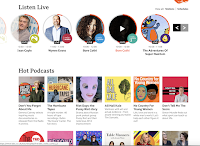Late night Women's hour:
- Is a spin of from a radio show called women's hour which was a long running BBC radio 4 daily magazine programme
- Late Might woman's hour is broadcast once a month, late at night, is presented by Lauren Laverne and features a number of female panellists
- Each episode focuses on a certain theme thats relevant to their middle class middle age female
- 11pm Friday Night (also known as the grave yard slot)
- Broadcasted by the BBC - BBC radio 4 started in 2015
Episode notes:
- Subject: Homes
- Explores wider cultures e.g looks at the word "hygge- being comfy" which is a Danish word
- Family orientated would appeal to possible stay at home mums
- Has an author of a cookery book as part of the panel
- Aimed at a more educated audience through the use of big words, discussions on politics, feminism and the home ('democratisation', 'antithesis', 'egalitarian')
- Panellists enjoy craft which is a typical female activity
- Discusses individuality and personality- the way people are overtaken by Ikea and commercialised images of the ideal home
- Seems to express the need for comfort, striving for perfection
- A sense of inclusivity between individuals and the feeling of how you bring each other together
- Not a lot of focus on strong, feminist perspectives but more about the way that women had been expected to do in the past and still are today
- Some conversation on emotion which men may not typically understand however if men listen to the show they may get a greater understanding from the show of how the women in their life feel
- very middle class- snob like " i knew my marriage was over when we were ordering a Ikea wardrobe'
- Round table discussion
- 'Winter mug'
- mode of address is very middle class
- 'Square scarfs'
- 'Only have 20 books'- the response was shock from the other panellists
- It paints a 'utopia' for the audience
- The show could be argued as sexist- draws a binary between men and women- emotional women and hard working men
- Seen as the edgier version
- Never discusses sex
Meet needs: needs for perfection, the way that the audience wants to feel with the trends, possibly need to know about culture- middle class accent also through the way she speaks- very gentle/egalitarian
Regulatory issues: even though its on at a set time anyone can listen to it at any time or day without any restrictions through podcasts- radio is regulated by ofcom the same as tv
As the BBC: fits perfectly with their image- not daring- polite and very inclusive
BBC is a PBS (public broadcasting service) means it runs without any advertisement and relies on Tv license as funding
BBC have a remit they have to target a range of audiences through a range of shows
Its an institution which is there to make a profit and is held in such high regard that they almost become pretentious and views and presenters on the channel frown upon others
There image is really important to them
An example is Top Gear which is so different from Late nights women hour
They also sold of the great British bake off to make money and cut costs
Its an institution which is there to make a profit and is held in such high regard that they almost become pretentious and views and presenters on the channel frown upon others
There image is really important to them
An example is Top Gear which is so different from Late nights women hour
They also sold of the great British bake off to make money and cut costs
Womens hour: documentary:
- Used to encourage women to rebuild their lives after ww2
- First started 1946- end of world war 2
- Aired at 2pm to fit with 'Womanly chores'
- Talks a lot about cooking and how to generally be a good housewife
- Purpose was to educate female audiences them while doing the housework/ ironing
- was moved from BBC radio 1 to BBC radio 4 in the 70's- diversification of audience
- Criticised as sexist to both men and women
- Another criticism was it was "too middle class" this came from the producer
Criticism's:
- Doesn't appeal to a wide target audience
- Overly middle class focus
- Unrelatable for most people
- It's boring
- Has little to do with working class people especially with their topics they discuss
- All female panel- sexist
- They make out Ikea is too common
- Aspiration and cultural capital of interior design
- Being evicted being spoken about as an adventure
- Oppositional readings
Reception theory- target audience identifies with it (preferred reading) where as some audiences feel excluded (oppositional reading).
How much does a TV license cost? 2019
Ways digital platforms have changed the way we consume radio:
- Podcasts- your able to skip to the parts you want to hear
- Don't have to listen to radio live anymore
- Online
- In the car- free don't need a TV license
- Online
- We stream everything
- You can actually watch the presenter talking live - online
- Radio gives audience a direct address
- Archiving
- Social media allows audiences to interact with it
- Apps offer a better user experience for the user
- Digital radio in cars- gets more channels- don't have to be near by- better reception
- You can download podcasts in advance
- With phones your able to use them anywhere
- Digital technologies give it a visual aspects- through thumb nails
- DIGITAL CONVERGANCE
- Audio streaming
- Digital audio broadcasting (DAB)
- Cross- platforms
- Podcasts
Regulation: the rules and restrictions different media products have to follow
(Ofcom regulates radio)
Nothing in Late night woman hour is controversial- it doesn't break any regulations
Localness- must talk about something local- doesn't apply to LNWH as its on a national Channel
Online media/digital technologies allow regulation to be ignored as even though its passed the watershed you can access the show at any time - regulation of radio is largely ineffective
4 fucks 2 shits 2 arses and 2 bastards- in a different episode - stats from The Sun newspaper- massive conflict of interest
Plurality- where a media product exhibits and gives voice to a wide range of ideological perspectives
The BBC is a public service broadcaster- it has self imposed remit to "inform, educate and entertain"
The BBC tries to incorporate Plurality through their range of channels and shows























